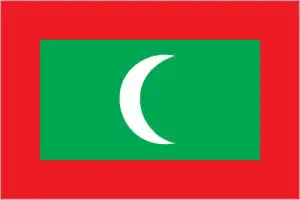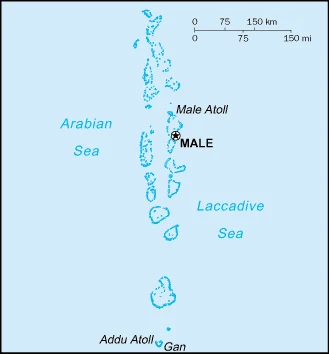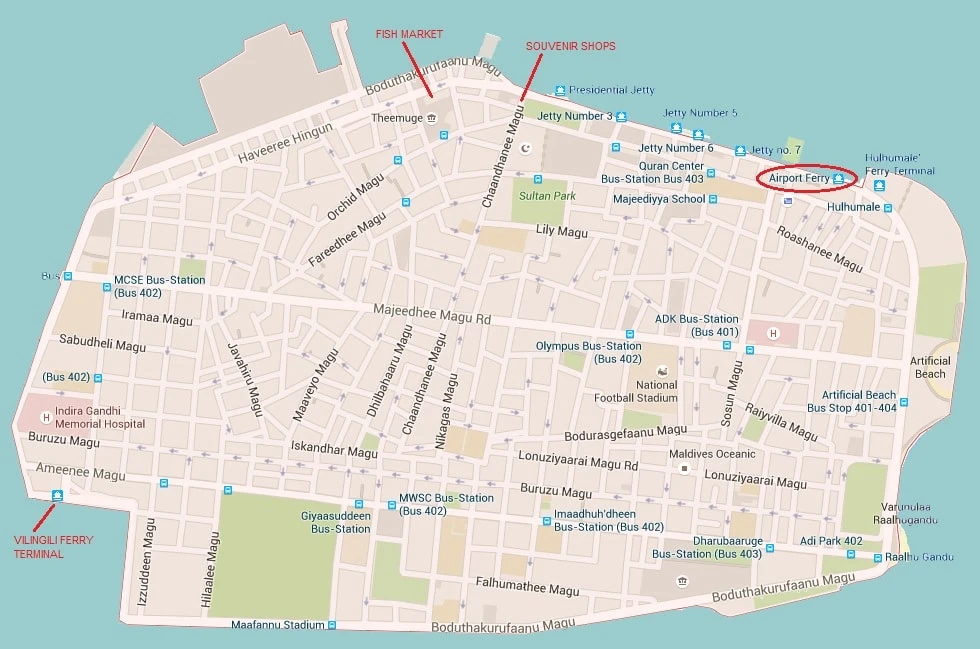Maldives Google Maps is a site/tool that offers a wide range of map views (topographic, satellite, street view) and navigation options, with little effort on your part, yet efficiently. If you need to plan a trip to a new place like the Maldives, Google maps are available on desktop, mobile, or tablet. This Google maps and information page is dedicated to the Maldives, Asia (22 countries), showing its location, country facts, details about its capital city, Male, and plenty of other information which may be interesting when you visit this Asian state.
Quick links: Google maps Maldives, Male Google maps, Driving Directions Maldives, Printable Road Map.

About Maldives in a nutshell
- Conventional short form of the name: Maldives
- The conventional long form of the name: Republic of Maldives
- Local long form: Dhivehi Raajjeyge Jumhooriyyaa
- Local short form: Dhivehi Raajje
- Former name(s): N/A
- Etymology: archipelago apparently named after the main island (and capital) of Male; the word Maldives means the islands (dives) of Male; alternatively, the name may derive from the Sanskrit word maladvipa meaning garland of islands; Dhivehi Raajje in Dhivehi means Kingdom of the Dhivehi people.
- The legal system in Maldives: Islamic (sharia) legal system with English common law influences, primarily in commercial matters.
- Climate: Tropical. Rain falls throughout the year, but is heaviest JuneNovember, during the monsoon. Violent storms occasionally hit the northern islands.
- The national symbols are coconut palm, yellowfin tuna; national colors: red, green, white.
- Internet TLD: .mv
The southernmost coral rings of this archipelago of 26 atolls, southwest of Sri Lanka, lie just off the equator. The 1,192 coral islands and reefs that make up the atolls are 750 km long by 120 km wide, but the total area of the atolls is less than 300 km2. Even the highest island rises no more than 2.5 meters, so the sea swell generated by the December 2004 Sumatra earthquake completely covered the archipelago. With tourism accounting for a fifth of the country’s national income and almost two-thirds of its foreign exchange earnings, the damage was quickly repaired. The climate of the islands – and the tourist season – is regulated by the monsoon. The dry northeast monsoon is the peak tourist season from December to April, with more tourists and higher prices. From May to November, the southwest monsoon, with its rainfall, also drives away tourists – when resort prices are lower. The Maldives Sultanate came under Dutch and then British patronage. Independent since 1965, it has been a republic since 1968. The Muslim population is only allowed to interact with tourists in the almost hermetically sealed resorts in the atolls around the capital under strict rules.
The islands, which all lie below 4 ft (1.2 m), are threatened by rising sea levels brought about by global warming and climatic changes.
Background
A sultanate since the 12th century, the Maldives became a British protectorate in 1887. The islands became a republic in 1968, three years after independence. President Maumoon Abdul GAYOOM dominated Maldive’s political scene for 30 years, elected to six successive terms by single-party referendums. Following political demonstrations in the capital, Male, in August 2003, GAYOOM and his government pledged to embark upon a process of liberalization and democratic reforms, including a more representative political system and expanded political freedoms. Political parties were legalized in 2005. In June 2008, a constituent assembly – termed the Special Majlis – finalized a new constitution ratified by GAYOOM in August 2008. The first-ever presidential elections under a multi-candidate, multi-party system were held in October 2008. GAYOOM was defeated in a runoff poll by Mohamed NASHEED. A political activist was jailed several years earlier by the GAYOOM regime. In early February 2012, after several weeks of street protests in response to his ordering the arrest of a top judge, NASHEED purportedly resigned the presidency and handed over power to Vice President Mohammed WAHEED Hassan Maniku.
A government-appointed Commission of National Inquiry concluded there was no evidence of a coup, but NASHEED contends that police and military personnel forced him to resign. NASHEED, WAHEED, and Abdulla YAMEEN Abdul Gayoom ran in the 2013 elections, with YAMEEN ultimately winning the presidency after three rounds of voting. As president, YAMEEN weakened democratic institutions, curtailed civil liberties, jailed his political opponents, restricted the press, and exerted control over the judiciary to strengthen his hold on power and limit dissent. In September 2018, YAMEEN lost his reelection bid to Ibrahim Mohamed SOLIH, a parliamentarian of the Maldivian Democratic Party (MDP), who supported a coalition of four parties that came together to defeat YAMEEN and restore democratic norms to the Maldives. In April 2019, SOLIH’s MDP won 65 of 87 seats in Parliament.
Geography
Consists of low-lying islands and coral atolls. The larger ones are covered in lush, tropical vegetation.

Set in the Indian Ocean, southwest of Sri Lanka, the Maldives is an archipelago of 1191 small coral islands or atolls. Two hundred are inhabited. The word atoll comes from the Dhivehi word atoll.
This state is located in Southern Asia, a group of atolls in the Indian Ocean, south-southwest of India, under the coordinates of 3 15 N, 73 00 E, covering an area of 298 sq km with a coastline of 644 km. Maldives is About 1.7 times the size of Washington, DC.
Flat, with white sandy beaches, Villingi island is 5 m as the highest point of Maldives, while the Indian Ocean is 0 m as the lowest point, causing a mean elevation of 2 m throughout the country. With a total of 298 sq km, Maldives has 298 sq km of land and 0 sq km of water surface area.
The smallest Asian country; an archipelago of 1,190 coral islands grouped into 26 atolls (200 inhabited islands, plus 80 islands with tourist resorts); strategic location astride and along major sea lanes in the Indian Ocean
The climate in the Maldives is as follows: Tropical, hot, humid, dry, northeast monsoon (November to March), rainy, southwest monsoon (June to August).
When you visit the Maldives, the natural hazards shall be considered: Tsunamis; islands’ low elevation makes them sensitive to sea-level rise.
None of the following major health-threatening issues shall be considered when visiting the Maldives.
Current environmental issues affecting the Maldivian people: depletion of freshwater aquifers threatens water supplies; inadequate sewage treatment; coral reef bleaching.
Google maps Maldives
The capital and other divisions
Capital city: Male found under the coordinates 4 10 N, 73 30 E, applying the time zone UTC+5 (10 hours ahead of Washington, DC, during Standard Time), using the following daylight saving time: none.
Male is the capital city of Maldives and lies on the southwest end of the country. Male City is divided into different sections, each with its distinctive features. The main city center consists of statues, mosques, and churches. There are also traditional markets selling local produce such as fruits and vegetables.
Maldives became independent on 26 July 1965 (from the UK), and its national holiday is Independence Day, 26 July (1965).
Administrative divisions: 21 administrative atolls (atholhuthah, singular – atholhu); Addu (Addu City), Ariatholhu Dhekunuburi (South Ari Atoll), Ariatholhu Uthuruburi (North Ari Atoll), Faadhippolhu, Felidhuatholhu (Felidhu Atoll), Fuvammulah, Hahdhunmathi, Huvadhuatholhu Dhekunuburi (South Huvadhu Atoll), Huvadhuatholhu Uthuruburi (North Huvadhu Atoll), Kolhumadulu, Maale (Male), Maaleatholhu (Male Atoll), Maalhosmadulu Dhekunuburi (South Maalhosmadulu), Maalhosmadulu Uthuruburi (North Maalhosmadulu), Miladhunmadulu Dhekunuburi (South Miladhunmadulu), Miladhunmadulu Uthuruburi (North Miladhunmadulu), Mulakatholhu (Mulaku Atoll), Nilandheatholhu Dhekunuburi (South Nilandhe Atoll), Nilandheatholhu Uthuruburi (North Nilandhe Atoll), Thiladhunmathee Dhekunuburi (South Thiladhunmathi), Thiladhunmathee Uthuruburi (North Thiladhunmathi).
People and society
Maldivians, all Sunni Muslims, are descended from Sinhalese, Dravidian, Arab, and black ancestors. A third of the population lives Male. Tourism has grown on separate resort islands away from residents. Influential families controlled politics until young reformers pushed for parties to be legalized in 2005. However, a legislative stalemate followed, and a controversial presidential election in 2013 returned the former elite to power.
The population in the Maldives is 390,669 (July 2021 estimate), with an average of -0.12% (2021 estimate) change. That means the Maldives is the No. 176 in the world’s populated rank list. With an average of 29.5 years median age (29.2 years for males and 29.2 years for women), Maldives ranks No. 129 on the globe’s median age rank list.
The people living in this country are the Maldivian(s) (noun) or Maldivian (adjective) and belong mainly to the following ethnic groups: a homogeneous mixture of Sinhalese, Dravidian, Arab, Australasian, and African resulting from historical changes in regional hegemony oversea trade routes.
They speak Dhivehi (official language, dialect of Sinhala, script derived from Arabic), English (spoken by most government officials) languages, and practice the following religions: Sunni Muslim (official).
We can conclude the following about the population in the Maldives: About a third of the population lives in the centrally located capital city of Male and almost a tenth in southern Addu city. The remainder of the populace is spread over the archipelago’s 200 populated islands. In the Maldives, we are talking about 41.1% (2021) of the total population is living in cities, and most of them reside in the following municipalities: 177,000 Male (capital city) (2018).
Industry
Fluctuating tourist industry is the economic mainstay. Fish, especially tuna, are the main export. Upgraded to a “middle income” country, despite 2004 tsunami damage.
The Maldives has quickly become a middle-income country, driven by the rapid growth of its tourism and fisheries sectors, but it still contends with a growing fiscal deficit. Funded mainly by China, infrastructure projects could add significantly to debt levels. Political turmoil and the declaration of a state of emergency in February 2018 led to travel warnings by several countries whose citizens visit the Maldives in significant numbers. Still, the overall impact on tourism revenue was unclear. In 2015, Maldives Parliament passed a constitutional amendment legalizing foreign land ownership; foreign land-buyers must reclaim at least 70% of the desired land from the ocean and invest at least $1 billion in a construction project approved by Parliament. Diversifying the economy beyond tourism and fishing, reforming public finance, increasing employment opportunities, combating corruption, cronyism, and a growing drug problem are the government’s near-term challenges. Over the longer term, Maldivian authorities worry about the impact of erosion and possible global warming on their low-lying country; 80% of the area is 1 meter or less above sea level.
The Maldives is rich in the following natural resources: Fish.
The main industrial sectors are tourism, fish processing, shipping, boat building, coconut processing, woven mats, rope, handicrafts, coral, and sand mining.
The country’s export sectors are particularly strong in fish products, natural gas, scrap iron, jewelry, liquid pumps (2019), partnering with these nations: Thailand 24%, United States 13%, China 12%, France 11%, Germany 11%, Italy 5%, United Kingdom 5% (2019). The export trade resulted in $3.72 billion. Note: Data are in current year dollars (2019 estimate). In a global rank of the export, values resulted in Maldives’s position of 138.
Land use in Maldives: 3% (2018 estimate) forest, 73.7% (2018 estimate) other.
The arable land area is 10% (2018 estimate), and the agricultural land is 23.3% (2018 estimate). Land use for permanent crops 10% (2018 estimate), permanent pasture 3.3% (2018 estimate). The sum of the area of the irrigated land is 0 sq km (2012).
The main agro-industrial products of Maldives are papayas, vegetables, roots/tubers nes, nuts, fruit, other meat, tomatoes, coconuts, bananas, maize.
The country typically needs to import: refined petroleum, fruits, furniture, broadcasting equipment, lumber (2019), partnering with the following nations: the United Arab Emirates 24%, China 16%, Singapore 14%, India 11%, Malaysia 6%, Thailand 5% (2019) in a sum value of $4.09 billion. Note: data are in current year dollars (2019 estimate) $4.1 billion. Note: data are in current year dollars (2018 estimate). This sum value on the global ranking list of imports resulted in Maldives 149.
Maldives Driving Directions
In this post, you learned about Maldives, Southern Asia, a group of atolls in the Indian Ocean, south-southwest of India. We published some basic information about its capital, Male, and the Maldivian nation.
Are you interested in visiting the Maldives and looking for driving directions? Click here to plan your route, or see a printable road map of the Maldives below for an overview of the route network.
Printable map of Maldives

Did you know about Maldives?
The Maldives is an island country in the Indian Ocean, southwest Sri Lanka. Known for its white sandy beaches and crystal blue water, Maldives is a popular tourist destination for honeymooners, couples, and families. The Maldivian government takes protecting its environment very seriously and prohibits coral mining, fishing on certain reefs, and the use of plastic bags while on resort islands. This makes it one of the cleanest and most beautiful locations globally!
After virtually visiting the Maldives, you may also be interested in the neighboring countries: none.
If you liked our Google map and the Maldives information page,
please share it with others or save the link https://www.drivingdirections.net in your bookmarks.
